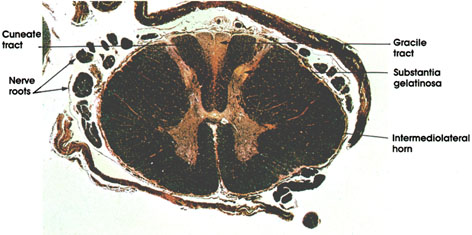

Plate 17.319 Spinal Cord Lesion
Ronald A. Bergman, Ph.D., Adel K. Afifi, M.D., Paul M. Heidger,
Jr., Ph.D.
Peer Review Status: Externally Peer Reviewed

Human, 10% formalin, Weigert-carmine, 9.4 x.
Gracile tract: Note that the gracile tract stains lighter than the adjacent cuneate tract. See Plates 317 and 322. This is due to the degenerating myelinated fibers in the gracile tract, which are not stained by this method. This slide was taken from a human with a spinal cord lesion in the dorsal (posterior) funiculus below the sixth thoracic segment. Fibers entering the spinal cord below this level form the gracile tract. The fibers entering above T6 form the cuneate tract and therefore escape degeneration.
Substantia gelatinosa: Contains 6 to 20 µm diameter neurons. Note small size compared with that of cervical cord. Concerned with sensory relay and integration.
Intermediolateral horn: Lateral gray horn. Characteristic of dorsal (thoracic) and upper lumbar segments. Contains sympathetic neurons.
Nerve roots: Incoming dorsal roots.
Next Page | Previous Page | Section Top | Title Page
Please send us comments by filling out our Comment Form.
All contents copyright © 1995-2025 the Author(s) and Michael P. D'Alessandro, M.D. All rights reserved.
"Anatomy Atlases", the Anatomy Atlases logo, and "A digital library of anatomy information" are all Trademarks of Michael P. D'Alessandro, M.D.
Anatomy Atlases is funded in whole by Michael P. D'Alessandro, M.D. Advertising is not accepted.
Your personal information remains confidential and is not sold, leased, or given to any third party be they reliable or not.
The information contained in Anatomy Atlases is not a substitute for the medical care and advice of your physician. There may be variations in treatment that your physician may recommend based on individual facts and circumstances.
URL: http://www.anatomyatlases.org/